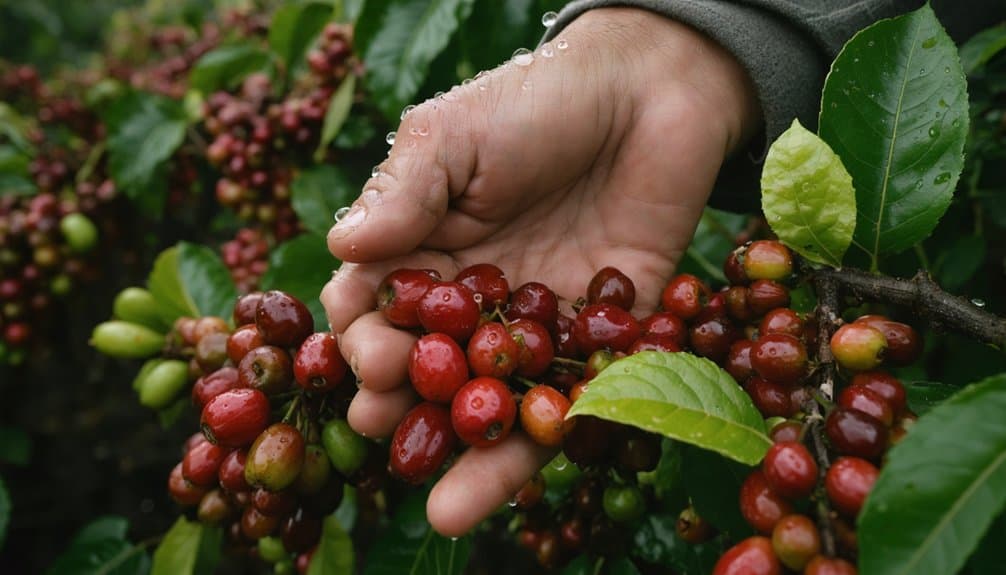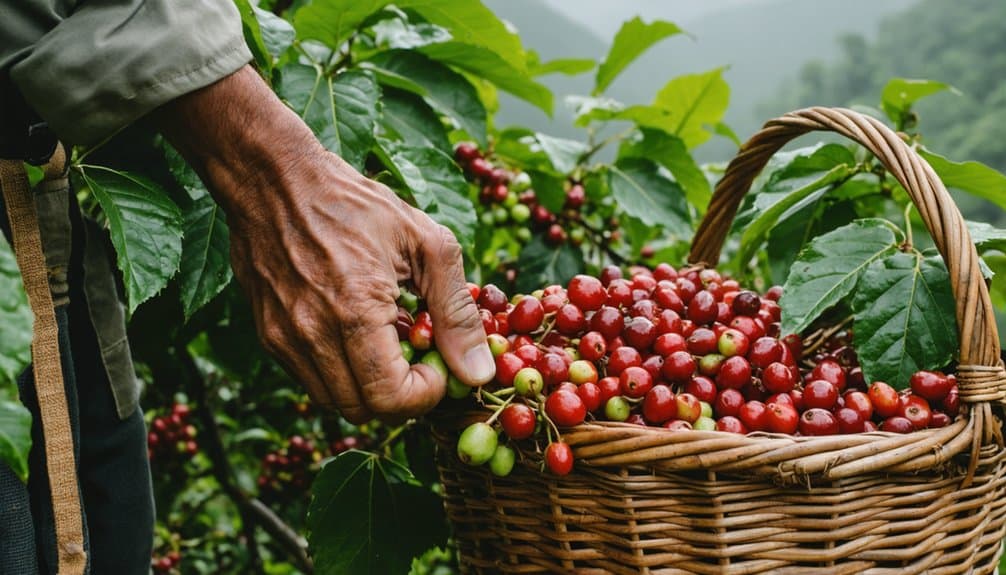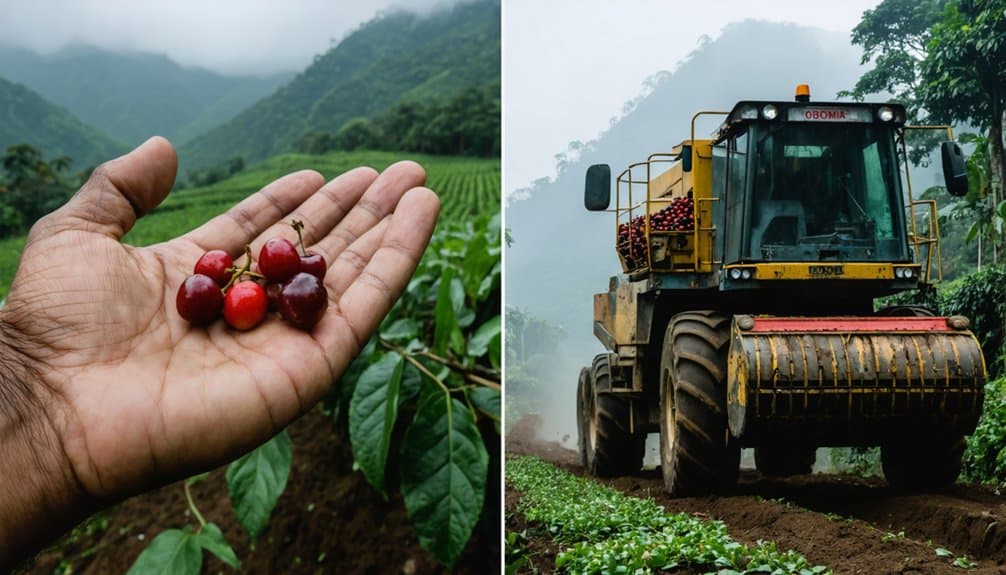Colombian farmers hand-pick coffee cherries at peak ripeness, selecting only those that display a deep burgundy-red color and yield slightly to touch.
You’ll find harvesters examining each tree multiple times during harvest season, collecting 50-120 kilograms of cherries daily.
They prioritize traditional manual selection over mechanical methods, especially in mountainous regions, to maintain premium Arabica quality.
This meticulous process marks just the beginning of Colombia’s renowned coffee adventure.
Key Takeaways
- Colombian farmers exclusively hand-pick coffee cherries, selecting only those with at least two-thirds red coloration for optimal ripeness.
- Workers inspect each coffee tree multiple times during harvest, gathering approximately 90 kilos of perfectly ripe cherries daily.
- Farmers use a simple touch test to verify ripeness, ensuring cherries yield slightly when squeezed before picking.
- The main harvest occurs October to January, with selective picking preventing mixing of ripe and unripe cherries.
- Processing begins immediately after picking, with farmers sorting, depulping, and washing cherries to maintain quality standards.
The Art of Hand-Picking Coffee Cherries

While mechanized harvesting dominates many agricultural sectors, Colombia’s coffee farmers maintain the time-honored practice of hand-picking coffee cherries for superior quality control.
You’ll find skilled workers meticulously examining each tree multiple times during harvest season, selecting only perfectly ripe cherries while leaving immature ones to develop.
This precision-focused approach yields up to 90 kilos of premium cherries per worker daily, requiring minimal post-harvest sorting.
You’re participating in a tradition that guarantees ideal flavor development and consistently high quality, especially vital for specialty coffee production.
The selective nature of hand-picking contributes directly to Colombia’s reputation for excellence in coffee production.
Their primary harvest occurs from October to January, with a second smaller harvest providing additional opportunities for quality cherry selection.
Identifying the Perfect Ripeness
You’ll observe that coffee cherries progress through distinct color transformations, from green to yellow-red and ultimately to a deep crimson, signaling their advancing stages of maturity.
When examining cherries in Colombia, you must verify that the red coloration covers at least two-thirds of the fruit’s surface area to meet technical standards.
You can confirm ideal ripeness by gently squeezing the cherry between your fingers—a perfectly ripe cherry will yield slightly under pressure and feel firm but not hard.
This precise selection process helps farmers maintain consistent quality levels throughout their harvest.
Color Changes Guide Pickers
As coffee cherries mature on the plant, their color transformation serves as a critical indicator of ripeness, with peak harvesting occurring when bright to dark red hues cover at least two-thirds of the fruit’s surface area.
You’ll rely on these visual cues heavily during selective picking, ensuring best sugar content and Brix levels.
In Colombia’s diverse growing regions, you’ll find altitude affects maturation rates and color development.
You’ll need to adapt your picking standards accordingly, as highland cherries often mature more slowly.
Whether you’re employing selective hand-picking or managing larger operations, these color indicators remain your most reliable guide for achieving premium coffee quality.
Skilled harvesters can collect between 50 to 120 kilograms of ripe cherries each day through careful selection.
Touch Test for Ripeness
Beyond visual inspection, the touch test provides Colombian coffee farmers with a precise method for determining cherry ripeness.
You’ll find that gently squeezing each cherry reveals if it’s at peak ripeness – the seed should easily fall out just before the fruit becomes completely red. While this hands-on approach is labor-intensive, it’s vital for quality control.
You’ll need to check each cherry individually, as strip-picking or machine harvesting can mix ripe and unripe cherries.
Experienced pickers in your farming community rely on this tactile technique to complement visual assessment, ensuring only perfectly ripe cherries make it to processing.
This labor-intensive method aligns with Colombia’s traditional selective picking method, which consistently produces superior quality beans.
Multiple Harvest Cycles Throughout the Season

While many coffee-growing regions experience a single annual harvest, Colombia’s unique geographical positioning and diverse microclimates enable multiple harvest cycles throughout the year.
You’ll find that even within relatively small areas, varying altitudes and rainfall patterns create distinct picking schedules.
The main harvest occurs from October to February in regions like Antioquia and Caldas, while Cauca, Huila, and Nariño’s premium harvests run from April to July.
These staggered cycles mean you’re accessing fresh coffee year-round.
Rain triggers blooming after dry spells, and cherries develop over six months, requiring precise timing for ideal picking.
Each harvest cycle requires farmers to document what they find meticulously to maintain consistent quality across different picking periods.
Quality Control During Selection
When Colombian coffee farmers select cherries for harvest, they follow rigorous quality control measures that emphasize the importance of proper ripeness.
You’ll find them carefully hand-picking only red or burgundy cherries, avoiding unripe green ones that lack flavor and overripe fruits that risk decay.
The selection process relies on selective picking rather than strip-picking, ensuring superior quality control.
You’ll see farmers using flotation techniques at wet mills to separate any remaining green cherries before pulping.
These family-owned farms represent nearly 600,000 operations across Colombia’s diverse growing regions.
They’ll calibrate their pulping machines precisely to match specific cherry types, maximizing both quality and yield during processing.
Traditional Vs Modern Picking Methods

While you’ll find that most Colombian coffee cherries are still hand-picked due to steep terrain and quality requirements, mechanical harvesting methods have emerged as alternatives in flatter regions.
You can observe significant differences between manual selection, which guarantees only ripe cherries are picked, and mechanical stripping, which removes all cherries regardless of ripeness.
These contrasting approaches reflect the industry’s balance between traditional quality-focused practices and modern efficiency-driven techniques, though hand-picking remains dominant in Colombia’s mountainous coffee regions.
Quality control inspectors ensure cherries are same color and ripe to maintain premium standards.
Hand Picking Still Dominates
Despite technological advances in coffee harvesting, traditional hand-picking remains the dominant method for Colombian coffee farmers, particularly in regions producing specialty-grade Arabica beans.
You’ll find this approach preserves coffee’s distinctive qualities through selective harvesting, where farmers expertly identify and collect only ideally ripe cherries.
This meticulous process is considered the most labour-intensive approach in coffee harvesting today.
Key advantages of Colombia’s hand-picking dominance:
- Guarantees 2.5 kg of precisely selected cherries for every 500 g of finished product
- Maintains strict quality control through multiple harvest passes
- Creates sustainable employment within coffee-growing communities
- Preserves unique flavor profiles specific to each farm
- Reduces environmental impact by avoiding mechanical stripping methods
Machine Vs Manual Selection
The fundamental differences between machine and manual coffee harvesting methods reflect a vital trade-off between efficiency and quality in modern coffee production.
You’ll find machines excel in productivity, harvesting 4000-5000 liters per hour on flat terrain, but they’ll collect cherries indiscriminately.
While modern harvesters offer adjustable selectivity, they can’t match the precision of manual picking. In fact, manual harvesters can yield about 60 liters per hour with careful selection.
When you’re selecting by hand, you’ll guarantee consistent ripeness and superior quality control, particularly essential for specialty Arabica beans.
Manual methods, though labor-intensive and costly, allow harvesting on varied terrains and produce premium results that mechanical systems simply can’t replicate.
The Journey From Branch to Processing
Colombian farmers initiate coffee processing by carefully selecting and removing ripe cherries from branches through a meticulous hand-picking method.
You’ll find this selective harvesting method guarantees peak quality by avoiding unripe or overripe cherries that could compromise flavor.
Research shows that accessing data-driven resources helps farmers optimize their harvesting techniques.
- Cherries undergo immediate sorting to remove foreign materials
- Depulping removes the fruit’s outer layer from the bean
- Washing cleans residual pulp using water immersion
- Drying takes 30-40 days in the washed method
- Threshing removes the final outer skin layer
This careful expedition transforms raw cherries into processed beans ready for roasting, maintaining Colombia’s high-quality coffee standards through precision and attention to detail.
FAQs
How Much Do Colombian Coffee Pickers Typically Earn per Day?
You’ll earn around 90,000 Colombian pesos ($25.50 USD) daily as a coffee picker when collecting 90 kilos at 1,000 pesos per kilo, though earnings fluctuate with harvest conditions.
What Safety Measures Do Coffee Pickers Use When Working on Steep Terrain?
You’ll need ergonomic baskets, secure footing equipment, and garruchas (counterbalance systems) when harvesting on slopes. Tarpaulins provide stability while collecting cherries, reducing slip-and-fall risks during picking operations.
How Do Weather Conditions Affect the Coffee Cherry Picking Schedule?
Predictable precipitation patterns determine your picking schedule, while temperature and terrain affect timing. You’ll need to monitor rainfall’s impact on flowering cycles and adjust harvesting based on ripening variations.
What Specific Training Do New Coffee Pickers Receive Before Starting Work?
You’ll receive hands-on training in ripeness identification, terrain navigation, quality control standards, and proper picking techniques, while learning post-harvest processes and safety protocols under experienced pickers’ supervision.
How Do Farmers Predict Their Annual Yield of Coffee Cherries?
Like puzzle pieces falling into place, you’ll combine machine learning models with weather data, crop management records, and traditional sampling methods (60 trees/hectare) to predict your annual coffee yield.
The Bottom Line
As you’ve learned, Colombian coffee farmers employ precise selection criteria to harvest only ideally ripe cherries.
“Time and patience yield perfection,” and you’ll find this reflected in their systematic approach to multiple picking cycles.
You’ll notice how their meticulous hand-selection process, combined with stringent quality control measures, guarantees that each cherry meets the 18-22% sugar content threshold before processing.
This scientific precision directly impacts your cup’s final flavor profile.
